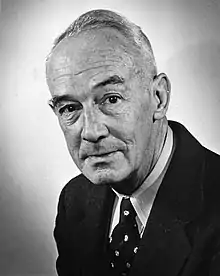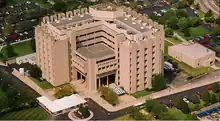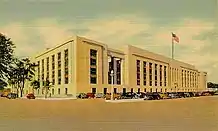.svg.png.webp) | |
| Agency overview | |
|---|---|
| Formed | December 30, 1943 |
| Preceding agency |
|
| Dissolved | December 31, 1966 |
| Superseding agency |
|
| Jurisdiction | Federal government of the United States |
| Headquarters | Washington, D.C. |
| Parent agency | U.S. Public Health Service |
The Bureau of State Services (BSS) was one of three principal operating agencies of the United States Public Health Service (PHS) from 1943 until 1966. The bureau contained the PHS divisions that administered cooperative services to U.S. states through technical and financial assistance, and included significant programs in community health, environmental health, and workforce development.
The Bureau was broken up at the beginning of the Public Health Service reorganizations of 1966–1973. The community health and workforce development divisions were eventually merged respectively into two divisions of the Health Resources and Services Administration, with the exception of the division that became the Centers for Disease Control and Prevention (CDC). Most of the Bureau's environmental health divisions became the core of the Environmental Protection Agency when it was created in 1971, with the remaining two divisions becoming the National Institute for Occupational Safety and Health within CDC, and the FDA Center for Devices and Radiological Health.
Formation

The Marine Hospital Service, the predecessor of the U.S. Public Health Service (PHS), formed its first internal divisions in 1899.[3] By 1943, PHS contained eight administrative divisions, plus the National Cancer Institute, St. Elizabeths Hospital, and Freedmen's Hospital under the direct supervision of the Surgeon General. These divisions often had overlapping scopes, which was seen as administratively unwieldy. Additionally, some of these had been created and specified through several pieces of legislation that were inconsistent in their scope, while some had been created internally by PHS or delegated from its parent agency, the Federal Security Agency.[4]
A 1943 law (57 Stat. 587) collected PHS's divisions into three operating agencies.[4] These were the National Institute of Health for laboratory research, the Bureau of Medical Services for direct patient care through hospitals and clinics, and the Bureau of State Services for administering cooperative services to U.S. states through technical and financial assistance.[4][5]
BSS was largely the successor to the Division of States Relations, which had grown out of the Domestic Quarantine Division, one of the original 1899 divisions. The Division of States Relations became part of BSS upon its creation, but was soon split into eleven separate divisions. The other two preexisting divisions incorporated into BSS were the Division of Venereal Disease, and the Division of Industrial Hygiene.[3]
Functions
The name of the bureau implied that its programs would be directed towards cooperation with U.S. states, including both technical expertise and financial grants-in-aid, and its functions were quite diverse.[6]
Its disease prevention activities were focused on public health surveillance, testing and evaluation of preventative and diagnostic measures, development of educational and training materials, and grants to states. The Communicable Disease Center focused on infectious diseases, and was based in Atlanta due to its initial mission of eradicating malaria in the United States. The Division of Chronic Diseases focused on other diseases, mainly cancer, diabetes, arthritis, heart disease, neurological disease, and mental retardation, in addition to aging and nursing homes. The Division of Dental Public Health focused on prevention and treatment of dental diseases. Tuberculosis and venereal diseases originally had their own divisions, but they came to be grouped with the Division of Chronic Diseases in the 1950s,[3] and after 1960 were transferred to the Communicable Disease Center.[6]
BSS's environmental health programs largely arose from Stream Pollution Investigations Station in Cincinnati.[7] It had been created in 1912[8][9] and occupied a former U.S. Marine Hospital located in the former Kilgour Mansion.[10][11] In the late 1940s it expanded into air, industrial, and chemical pollution and radiological health research,[7] and in 1954 it moved to the newly constructed Robert A. Taft Sanitary Engineering Center.[8][12] The occupational health programs arose from the Office of Industrial Hygiene and Sanitation, which was established in 1914, became the Division of Industrial Hygiene within the National Institute of Health in 1937, and moved into BSS upon its creation in 1943. Its primary functions moved from Bethesda to Cincinnati in 1950.[13]
BSS's workforce development programs were centered in both the Division of Public Health Nursing and the Division of Dental Public Health. These programs sought to assist the training of dentists and nurses through advice, construction and project grants to states, and traineeships. It also provided advice on the planning and administration of health services.[6]
During some of its existence, BSS also had responsibility for funding hospital construction by the states as part of the Hill–Burton Act, Mental Retardation Facilities Construction Act, and Health Professions Educational Assistance Act of 1963. These programs were through the Division of Hospital and Medical Facilities, which was instead part of the Bureau of Medical Services during the 1950s, but was part of BSS before and after this period.[6]
Organizational development
BSS began with the three existing Divisions of States Relation, Industrial Hygiene, and Venereal Disease. As part of the initial organization of the bureau, the Division of States Relations gave rise to eleven new divisions: the Division of Tuberculosis Control in 1944; the Communicable Disease Center and Division of Hospital Facilities in 1946; and the Divisions of Chronic Disease, Dental Public Health, Engineering Resources, Public Health Education, Public Health Nursing, Sanitation, State Grants, and Water Pollution Control in 1949. Also in 1949, the Division of Hospital Facilities was transferred to the Bureau of Medical Services. In 1951, the Division of Chronic Disease and Division of Tuberculosis were consolidated into the Division of Chronic Disease and Tuberculosis.[3]
A major realignment occurred in 1954, with most of the existing divisions being reorganized as programs under a few new divisions:[3]
- The Division of General Health Services absorbed the Divisions of Public Health Nursing, Public Health Education, and State Grants.
- The Division of Special Health Services absorbed the Divisions of Chronic Disease and Tuberculosis, Occupational Health, and Venereal Disease.
- The Division of Sanitary Engineering Services absorbed the Divisions of Engineering Resources, Sanitation, and Water Pollution Control.
The Communicable Disease Center, Division of Dental Public Health, and Division of International Health remained independent as of 1956.[5] The Division of International Health was part of BSS during 1953–1959, but was part of the Office of the Surgeon General before and after this period.[3]
During 1958–61, these changes were largely reversed, with many of the programs reemerging as independent divisions:
- The Division of General Health Services was superseded by Division of Community Health Practice, with the Division of Public Health Nursing becoming independent.[3]
- The Division of Special Health Services was abolished,[3] with its programs promoted into the Divisions of Chronic Disease, Occupational Health, and Accident Prevention.[14]
- The Division of Sanitary Engineering Services was superseded by the Division of Environmental Engineering and Food Protection, with the separate Division of Air Pollution Control and Division of Water Supply and Pollution Control being established.[3] The Division of Radiological Health was also formed during this period.[15]
In addition, the Divisions of Dental Public Health and Public Health Nursing absorbed their corresponding divisions from the Bureau of Medical Services; the Division of Hospital and Medical Facilities was transferred from the Bureau of Medical Services, and the National Center for Health Statistics was created from the old National Office of Vital Statistics.[14] In 1960, these divisions were organized into two units, the Community Health Divisions and Environmental Health Divisions.[3]
In 1966, the Division of Water Supply and Pollution Control was transferred to the Department of the Interior, becoming the Federal Water Pollution Control Administration.[16] In 1967, the Communicable Disease Center took over the Division of Foreign Quarantine from the Bureau of Medical Services.[17]
Fate

.jpg.webp)


BSS was abolished at the beginning of 1967 in the first of four major reorganizations of PHS. In quick succession, PHS would be reorganized into three new bureaus, and then into two broad operating agencies, which would both be broken up by 1973, giving way to PHS's modern structure.[3][16][18]
Most of BSS's Community Health Divisions would join with the Bureau of Medical Services to form the Bureau of Health Services in 1967, and then become part of the Health Services and Mental Health Administration (HSMHA) in 1968. At the same time, BSS's divisions relating to training and professional development became the Bureau of Health Manpower in 1967, which was absorbed by NIH in 1968.[3][18] After the 1973 breakup of HSMHA, both these bureaus' successors would largely become the modern Healthcare Systems Bureau and Bureau of Health Workforce of the Health Resources and Services Administration, respectively. The only exception was the Center for Disease Control (CDC), which became its own operating agency within PHS.[18]
BSS's Environmental Health Divisions became part of the Bureau of Disease Prevention and Environmental Control in 1967,[3][18] and then the Consumer Protection and Environmental Health Service (CPEHS) in 1968.[18] Most of the CPEHS divisions would then form the core of the Environmental Protection Agency when it was created in 1971,[16][19] except for two divisions that would become the National Institute for Occupational Safety and Health within the CDC,[13] and the Center for Devices and Radiological Health within the Food and Drug Administration.[20]
Chiefs
The Chief of the Bureau of State Services was one of the positions holding the title of Assistant Surgeon General.[1][24][25]
- Lewis Ryers Thompson (1943–1946)[1][2]
- Charles L. Williams (1946–1951)[24][26][27]
- Joseph Walter Mountin (1951–1952)[28][2][29]
- Otis L. Anderson (1952–1957)[30][31]
- David E. Price (1958–1960)[32][33]
- Theodore J. Bauer (1960–1962)[21]
- Robert J. Anderson (as of 1963)[23]
- Aaron W. Christensen (by 1965–1966)[25][34]
Divisions
| Division (name as of 1965, link to current successor)[6] | Establishment of earliest predecessor(s)[3] | 1954–1960 grouping[5] | 1960–1966 grouping[3] | 1968–1970 grouping[16][18] | 1973 grouping [16][18][35] |
|---|---|---|---|---|---|
| Division of Environmental Engineering and Food Protection | 1949, as Divisions of Engineering Resources and Sanitation | SES | EH | CPEHS | |
| Division of Water Supply and Pollution Control | 1949 | EPA | |||
| Division of Air Pollution | <1953, as Community Air Pollution Program | SES/SHS jointly | |||
| Division of Radiological Health | 1948, as Radiological Health Unit[20] | FDA | |||
| Division of Occupational Health | 1914, as Office of Industrial Hygiene and Sanitation[13] | SHS | CDC | ||
| Division of Accident Prevention | 1956, as Accident Prevention Program[36] | CH | abolished[37] | abolished | |
| Division of Chronic Diseases | 1949; absorbed Divisions of Venereal Disease (1918) and Tuberculosis Control (1944) | HSMHA | abolished[3][38] | ||
| Communicable Disease Center | 1942, as Office of Malaria Control in War Areas | independent within BSS |
independent within PHS | ||
| Division of Hospital and Medical Facilities | 1946 | part of BMS | HRA | ||
| Division of Community Health Practice | 1949, as Public Health Education and State Grants | GHS | |||
| Division of Nursing | 1949 | NIH | |||
| Division of Dental Public Health and Resources | 1949 | independent within BSS |
Key:
|
|
|
References
- 1 2 3 "Obituaries: Ass't Surg. Gen'l Lewis R. Thompson, USPHS, Ret". Military Medicine. 116 (1): 72. January 1, 1955. doi:10.1093/milmed/116.1.72 (inactive August 1, 2023).
{{cite journal}}: CS1 maint: DOI inactive as of August 2023 (link) - 1 2 3 Lyons, Michele (April 3, 2006). 70 Acres of Science: The National Institute of Health Moves to Bethesda. National Institutes of Health. pp. 19, 89.
- 1 2 3 4 5 6 7 8 9 10 11 12 13 14 15 16 "Records of the Public Health Service [PHS], 1912-1968". National Archives. August 15, 2016. Retrieved September 15, 2020.
- 1 2 3 "Reorganization and functions of the Public Health Service". United States Senate. 1943. pp. 4–6. Archived (PDF) from the original on September 9, 2020. Retrieved September 15, 2020 – via Internet Archive.
- 1 2 3 Executive Reference Book (Public Health Service Portion). U.S. Department of Health, Education, and Welfare. 1957.
- 1 2 3 4 5 Handbook on programs of the U.S. Department of Health, Education, and Welfare. U.S. Department of Health, Education, and Welfare. 1965.
- 1 2 Walsh, John (July 3, 1964). "Environmental Health: Taft Center in Cincinnati Has Been the PHS Mainstay in Pollution Research". Science. 145 (3627): 31–33. Bibcode:1964Sci...145...31W. doi:10.1126/science.145.3627.31. ISSN 0036-8075. PMID 14162688.
- 1 2 Rogers, Jerry R.; Symons, James M.; Sorg, Thomas J. (May 28, 2013). "The History of Environmental Research in Cincinnati, Ohio: From the U.S. Public Health Service to the U.S. Environmental Protection Agency". World Environmental and Water Resources Congress 2013. American Society of Civil Engineers: 33–37. doi:10.1061/9780784412947.004. ISBN 978-0-7844-1294-7.
- ↑ "Andrew W. Breidenbach Environmental Research Center". U.S. Environmental Protection Agency. April 1, 1990. pp. 2–3. Retrieved December 30, 2019.
- ↑ Furman, Bess (1973). A Profile of the United States Public Health Service, 1798–1948. U.S. Department of Health, Education, and Welfare. pp. 295–298.
- ↑ Rogers, Gregory Parker (September 24, 2010). Cincinnati's Hyde Park: A Queen City Gem. Arcadia Publishing. pp. 59–61. ISBN 978-1-61423-166-0.
- ↑ "Laboratory research, field investigation, and training program of the Robert A. Taft Sanitary Engineering Center at Cincinnati, Ohio". Public Health Reports. 69 (5): 507–512. May 1, 1954. ISSN 0094-6214. PMC 2024349. PMID 13167275.
- 1 2 3 The President's Report on Occupational Safety and Health. U.S. Departments of Labor and Heath, Education, and Welfare. 1972. pp. 153–154.
- 1 2 Organization of Federal Executive Departments and Agencies. United States Senate. 1961. pp. 19–20.
- ↑ Programs of the U.S. Department of Health, Education, and Welfare: An Executive Reference Book. U.S. Department of Health, Education, and Welfare. 1959. p. 27.
- 1 2 3 4 5 "Records of the Environmental Protection Agency [EPA]". National Archives. August 15, 2016. Section 412.2. Retrieved August 29, 2020.
- ↑ "Images From the History of the Public Health Service: Disease Control and Prevention, Fighting the Spread of Epidemic Diseases". U.S. National Library of Medicine. January 16, 2012. Retrieved September 16, 2020.
- 1 2 3 4 5 6 7 "Records of the Health Resources and Services Administration [HRSA]". National Archives. August 15, 2016. Section 512.2. Retrieved August 29, 2020.
- ↑ "Reorganization Plan No. 3 of 1970". U.S. Environmental Protection Agency. Retrieved August 29, 2020.
- 1 2 "CDRH Milestones". U.S. Food and Drug Administration. January 9, 2006. Retrieved August 29, 2020.
- 1 2 "1997 Distinguished Alumni Award Winner Theodore J. Bauer". University of Iowa Alumni Association. Archived from the original on May 30, 2013. Retrieved February 18, 2010.
- ↑ "Past CDC Directors/Administrators". U.S. Centers for Disease Control and Prevention. January 31, 2018. Retrieved September 16, 2020.
- 1 2 "Annual Report, U.S. Department of Health, Education, and Welfare 1963". Retrieved September 16, 2020 – via HathiTrust.
- 1 2 "Annual report of the Federal Security Agency Public Health Service, 1946". Retrieved September 16, 2020 – via HathiTrust.
- 1 2 "Professor Named to Health Group". The Ohio State Lantern. January 6, 1965. Retrieved September 16, 2020.
- ↑ "Annual report of the Federal Security Agency Public Health Service, 1951". Retrieved September 16, 2020 – via HathiTrust.
- ↑ "Presentation Ceremony for Mobile X-Ray Unit". Harry S. Truman Library and Museum. Retrieved September 16, 2020.
- ↑ Parran, Thomas (October 1952). "A Career in Public Health". Public Health Reports. 67 (10): 930–943. doi:10.2307/4588251. JSTOR 4588251. PMC 2030936. PMID 12983541.
- ↑ "News and Notes". Science. 114 (2970): 588–592. November 30, 1951. Bibcode:1951Sci...114..588.. doi:10.1126/science.114.2970.588. ISSN 0036-8075.
- ↑ "Annual report of the Federal Security Agency Public Health Service, 1952". Retrieved September 16, 2020 – via HathiTrust.
- ↑ Anderson, Otis L. (August 1, 1958). "Health Centers—How They May Be Set Up Most Effectively to Meet Total Health Needs". Military Medicine. 123 (2): 103–107. doi:10.1093/milmed/123.2.103. ISSN 0026-4075. PMID 13565421.
- ↑ "NIH Extramural Program Oral History Collection: David E. Price, Ph.D." U.S. National Library of Medicine. May 2, 1986. Retrieved September 16, 2020.
- ↑ "Person Record: Price, David E." NIH Office of History. Retrieved September 16, 2020.
- ↑ "Obituaries: Aaron William Christensen". The Washington Post. September 26, 2003. ISSN 0190-8286. Retrieved September 16, 2020.
- ↑ History, mission, and organization of the Public Health Service. U.S. Public Health Service. 1976. pp. 3–4, 20, 22.
- ↑ Reducing the Burden of Injury: Advancing Prevention and Treatment. National Academies of Sciences, Engineering, and Medicine. 1999.
- ↑ Rosenberg, M. L.; Fenley, M. A. (August 1, 1992). "The federal role in injury control". The American Psychologist. 47 (8): 1031–1035. doi:10.1037/0003-066x.47.8.1031. ISSN 0003-066X. PMID 1510331.
- ↑ Querec, Linda (October 29, 1990). "Request for Records Disposition Authority: Unscheduled Health Services Records" (PDF). pp. 1, 3–4.




